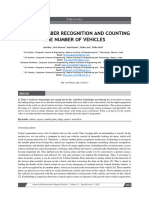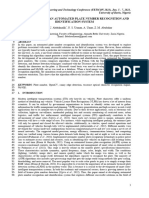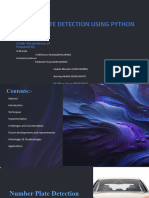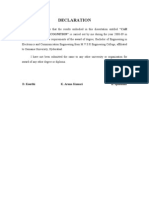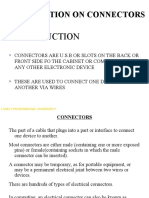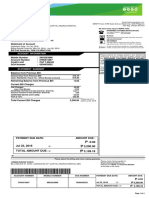IJCRT2212237
IJCRT2212237
Uploaded by
aimanfathimaa786Copyright:
Available Formats
IJCRT2212237
IJCRT2212237
Uploaded by
aimanfathimaa786Copyright
Available Formats
Share this document
Did you find this document useful?
Is this content inappropriate?
Copyright:
Available Formats
IJCRT2212237
IJCRT2212237
Uploaded by
aimanfathimaa786Copyright:
Available Formats
www.ijcrt.
org © 2022 IJCRT | Volume 10, Issue 12 December 2022 | ISSN: 2320-2882
NUMBER PLATE RECOGNITION USING
OPENCV
S.Swetha1,Dr K Merriliance M.Sc M.Phil PhD., 2
Department of Computer Applications, Sarah Tucker College, Thirunelveli-7.
Abstract: With the popularization of automobile and the progress of computer vision detection technology, intelligent license plate
detection technology has gradually become an important part of intelligent traffic management. License plate detection is used to
segment vehicle image and obtain license plate area for follow-up recognition system to screen. It is widely used in intelligent
traffic management, vehicle video monitoring and other fields. In this paper, two license plate detection methods are studied, one is
based on Sobel edge detection and the other is based on morphological gradient detection. Basing on OpenCV and PYTHON under
Windows system, two methods of license plate detection are implemented, and the two algorithms are compared in detail from the
aspects of license plate detection accuracy. These methods have high efficiency and good interactivity, which provide a reference
for later license plate recognition.
I. INTRODUCTION
Optical Character Recognition, or OCR, is a technology that enables people to convert different types of documents, such as scanned
paper documents, PDF files or images captured by a digital camera into editable and searchable data. Imagine there is a paper
document - for example, magazine article, brochure, or PDF contract a person sent to another person by email. Obviously, a scanner
is not enough to make this information available for editing, say in Microsoft Word. All a scanner can do is create an image or a
snapshot of the document that is nothing more than a collection of black and white or color dots, known as a raster image. In order to
extract and repurpose data from scanned documents, camera images or image-only PDFs, it needs an OCR software that would
single out letters on the image, put them into words and then - words into sentences, thus enabling people to access and edit the
content of the original document.
OCR is a field of research in pattern recognition, artificial intelligence and computer vision. OCR engines have been developed into
many kinds of domain-specific OCR applications, such as receipt OCR, invoice OCR, check OCR, legal billing document OCR.
Theycan also be used for Automatic number plate recognition.
OpenCV (Open Source Computer Vision) is a library of programming functions mainly aimed at real-time computer vision and
also a machine learning software library. Opencv was built to provide a common infrastructure for computer vision applications and
to accelerate the use of machine perception in the commercial products. Being a BSD-licensed product, OpenCV makes it easy for
businesses to utilize and modify the code. In this project OpenCV includes a statistical machine learning library that contains k-
nearest neighbor algorithm which is coded in Python (a widely used dynamic programming language).
MainAimofthisprojectistodevelopaLicensePlateRecognitionsoftwarewhichrecognises different types of characters in an
image and gives specific extracted output in text format.
The objective of this project is to extract characters from a License Plate with the use of computer vision libraries and algorithms. A
suitable algorithm needs to be constructed and trained for different set of images. The program code has to be written in Python with
the inclusion of suitable OpenCV libraries. The program should be able to extract the characters and print the output in text format
for training purpose.
II. LITERATURE SURVEY
In[1] The project will aim to develop a smart car plate recognition device that can monitor and survey the area, as well as
detect and analyze vehicle license plates. A sensor will detect the incoming vehicle, then a camera will take a screenshot of the
front of the vehicle with the license plate. The license plate is scanned then checked whether it is registered to determine whether it
is allowed or denied entry, and the device will troubleshoot by sending SMS to a fixed phone number regarding any issues.
In[2] The proposed system performs knowledge generation through data clustering mechanism. Further, the hidden
information pattern within the database of detected number plates is used to provide insight into the vehicle information towards
IJCRT2212237 International Journal of Creative Research Thoughts (IJCRT) www.ijcrt.org C257
www.ijcrt.org © 2022 IJCRT | Volume 10, Issue 12 December 2022 | ISSN: 2320-2882
decision making and analysis. The experimentation results of the proposed system show 85.3% of from plate recognition, 90.5%
for rear plate, 83.2% of localization and 80.5 % of character segmentation and 73.4 % of character recognition.
In[3] This device is utilized indensely populated region to spot the vehicles which are violating the traffic rules, are
handed down in malls to allot automobile parking space, identification of the stolen vehicles and also helpful in crime scene
investigation. Image of the vehicle is pre-processed by reading the image from a dataset (b) converting it into a gray-scale image
and (b) by removing the noises from the image using Gaussian techniques. This number plate is extracted from the image by
implementing the contour enhancement method and on extracted characters, machine learning algorithms are used to train the
model to perform the segmentation. Within the character recognition process, we classify the characters. The proposed number
plate detection technique shows significant improvement in accuracy rate when compared with standard existing systems.
In[4] The proposed system was evaluated on LP datasets from five countries which include South Korea, Taiwan, Greece,
USA, and Croatia. In addition, a small dataset containing LPs from 17 countries was collected to evaluate the effectiveness of the
multinational LP layout detection algorithm. The proposed ALPR system consumes about 42 ms per image on average for
extracting LP number. Experimental results demonstrate the effectiveness of our ALPR system.
In[5] The growing population of Nigeria has subsequently led to a higher number of cars on the road. This has resulted in
an increase in traffic violations and road-related crimes such as hit and run, kidnappings, robbery, etc. which have all contributed to
road insecurity in the country. It has also made it increasingly difficult to keep track of vehicles for law enforcement and traffic
management. Number plate recognition is still majorly carried out manually in most parts of Nigeria, which is neither efficient nor
effective. 5
III. METHODOLOGY
Approach:
To solve the defined character recognition process the python coded algorithm with OpenCVlibraries is used. The processing of
code is divided into the next categories:
Image acquisition
Pre-processing
Feature extraction
Detection/segmentation
High-level processing
Decision making
OCR
Licenseplaterecognitionisatechnologythatusesopticalcharacterrecognitiononimages to read vehicle registration plates. It can use
existing closed-circuit television, road-rule enforcement cameras, or cameras specifically designed for the task. It is used by police
forces around the world for law enforcement purposes, including to check if a vehicle is registered or licensed. It is also used for
electronic toll collection on pay-per-use roads and as a method of cataloging the movements of traffic for example by highways
agencies.
OpenCV
OpenCV (Open Source Computer Vision Library) is an open source computer vision and machine learning software library.
OpenCV was built to provide a common infrastructure for computer vision applications. Being a BSD-licensed product, OpenCV
makes it easy for anyone to utilize and modify the code.
k-nearest neighbors algorithm (k-NN)
OpenCV includes a statistical machine learning library that contains k-nearest neighbor algorithm which is coded in Python (a
widely used dynamic programming language).
In pattern recognition, the k-Nearest Neighbors algorithm (or k-NN for short) is a non-parametric method used for classification
and regression. In both cases, the input consists of the k closest training examples in the feature space. The output depends on
whether k-NN is usedfor classification or regression:
In k-NN classification, the output is a class membership. An object is classified by a majority vote of its neighbors, with the object
being assigned to the class most common among its k nearest neighbors (k is a positive integer, typically small). If k = 1, then the
object is simply assigned to the class of that single nearest neighbor. In k-NN regression, the output is the property value for the
object. This value is the average of the values of its k nearest neighbors.
Image acquisition
A digital image is produced by one or several image sensors i.e light-sensitive cameras. The pixel values typically correspond to
light intensity in one or several spectral bands (gray images or colour images), but can also be related to various physical measures,
such as depth,absorption or reflectance of sonic or electromagnetic waves.
IJCRT2212237 International Journal of Creative Research Thoughts (IJCRT) www.ijcrt.org C258
www.ijcrt.org © 2022 IJCRT | Volume 10, Issue 12 December 2022 | ISSN: 2320-2882
Pre-processing
Figure 1 Input Image
Before a computer vision method can be applied to image data in order to extract some specific piece of information, it is usually
necessary to process the data in order to assure that it satisfies certain assumptions implied by the following methods,
● Noise reduction in order to assure that sensor noise does not introduce false information.
● Contrast enhancement to assure that relevant information can be detected.
● Re-sampling in order to assure that the image coordinate system is correct.
● Scale space representation to enhance image structures at locally appropriatescales.
Figure 2 Binary Thresold Image
Feature extraction
Image features at various levels of complexity are extracted from the image data. Typicalexamples of such features are:
● Lines, edges and ridges.
● Localized interest points such as corners, points, etc.
● More complex features may be related to texture, shape or motion.
Detection/segmentation
At some point in the processing a decision is made about which image points or regions of the image are relevant for further
processing. For example
● Selection of a specific set of interest points
● Segmentation of one or multiple image regions which contain a specific object of interest.
High-level processing
At this step the input is typically a small set of data, a set of points or an image region which is assumed to contain a specific object.
The remaining processing deals with
● Verification of data that satisfy model-based and application specific assumptions.
● Estimation of application specific parameters, such as object pose or object size.
● Image recognition – classifying a detected object into different categories.
● Image registration – comparing and combining two different views of the sameobject.
Decision making
Making the final decision required for the following applications:
Pass/fail on automatic inspection.
Match / no-match in recognition.
IJCRT2212237 International Journal of Creative Research Thoughts (IJCRT) www.ijcrt.org C259
www.ijcrt.org © 2022 IJCRT | Volume 10, Issue 12 December 2022 | ISSN: 2320-2882
Detection/segmentation
At some point in the processing a decision is made about which image points or regions of the image are relevant for further
processing. For example
Figure 3 Output Image
● Selection of a specific set of interest points
● Segmentation of one or multiple image regions which contain a specific object of interest.
IV. CONLUSION
The message of this research is to show that free and open source technologies are matured enough for scientific computing
domains. The system works satisfactorily for wide variations in illumination conditions and different types of number plates
commonly found in India. It is definitely a better alternative to the existing proprietary systems, even though there are known
restrictions.
This Project provides an implementation of License Plate Recognition using Optical Character Recognition(OCR) which is an
electronic conversion of images of typed, handwritten or printed text into machine-encoded text. The project was able to study and
resolve algorithmic and mathematical aspects of the License Plate Recognition systems, such as problematic of computer vision,
pattern recognition, OCR & Neural networks.
License Plate Recognition solution has been tested on static snapshots of vehicles, which has been divided into several sets
according to difficulty. Sets of blurry and skewed snapshots give worse recognition rates than a set of snapshots which has been
captured clearly. The main objective of this project was not to find a one hundred percent recognizable set of snapshots, but to test
the invariance of the algorithms on random snapshots systematically classified to the sets according to their properties.
Source code obtained from different references could extract the characters up to only 5 in number, Improvisation of this source
code is done to extract more than 8 characters to reach indian standards. This is achieved by changing the dimensions of best
possible outcome of license plate region.
REFERENCES
1. M. Al-Mheiri, O. Kais and T. Bonny, "Car Plate Recognition Using Machine Learning," 2022 Advances in Science and
Engineering Technology International Conferences (ASET), 2022, pp. 1-6, doi: 10.1109/ASET53988.2022.9734830.
2. R. Agrawal, M. Agarwal and R. Krishnamurthi, "Cognitive Number Plate Recognition using Machine Learning and Data
Visualization Techniques," 2020 6th International Conference on Signal Processing and Communication (ICSC), 2020, pp. 101-
107, doi: 10.1109/ICSC48311.2020.9182744.
3. K. Anusha, S. Nachiyappan, M. Braveen, K. V. Pradeep and S. R. Yarlagadda, "A Simple Number Plate Detection Technique
with Support Vector Machine for On-Road Vehicles," 2022 International Virtual Conference on Power Engineering Computing
and Control: Developments in Electric Vehicles and Energy Sector for Sustainable Future (PECCON), 2022, pp. 01-06, doi:
10.1109/PECCON55017.2022.9851000.
4. C. Henry, S. Y. Ahn and S. -W. Lee, "Multinational License Plate Recognition Using Generalized Character Sequence
Detection," in IEEE Access, vol. 8, pp. 35185-35199, 2020, doi: 10.1109/ACCESS.2020.2974973.
5. F. A. Aiyelabegan, C. C. Emmanuel, S. Thomas, F. A. Imam, H. Haruna Ginsau and F. Onah, "Proposed Automatic Number
Plate Recognition System Using Machine Learning," 2022 IEEE Nigeria 4th International Conference on Disruptive Technologies
for Sustainable Development (NIGERCON), 2022, pp. 1-5, doi: 10.1109/NIGERCON54645.2022.9803181.
IJCRT2212237 International Journal of Creative Research Thoughts (IJCRT) www.ijcrt.org C260
You might also like
- Loudbox Mini SchematicsDocument8 pagesLoudbox Mini SchematicsMichelNo ratings yet
- License Plate RecognitionDocument22 pagesLicense Plate Recognition1240- BhanuNo ratings yet
- Typescript CheatsheetDocument1 pageTypescript CheatsheetVictor Azevedo100% (1)
- Rethinking Engineering Education at The Age of Industry 5.0Document8 pagesRethinking Engineering Education at The Age of Industry 5.0Silviana MaharaniiNo ratings yet
- Statistical Functions of EZRDocument3 pagesStatistical Functions of EZRbudiutom8307No ratings yet
- 8782-Article Text-22476-1-10-20240305Document7 pages8782-Article Text-22476-1-10-20240305suresh meruguNo ratings yet
- A Review Paper On License Plate Recognition SystemDocument3 pagesA Review Paper On License Plate Recognition SystemSen PaiiNo ratings yet
- Automated Vehicle License Plate Detection System Using Image Processing Algorithms PDFDocument5 pagesAutomated Vehicle License Plate Detection System Using Image Processing Algorithms PDFSaidur Rahman SidNo ratings yet
- DAPNRIS 2023 ConferenceDocument8 pagesDAPNRIS 2023 ConferencefabulouskauraNo ratings yet
- Survey (1) (AutoRecovered)Document11 pagesSurvey (1) (AutoRecovered)2100080063ai.dsNo ratings yet
- Pooja ReportDocument40 pagesPooja ReportPOOJA ARENo ratings yet
- AbhiDocument20 pagesAbhipython6miniNo ratings yet
- JPNR - S06 - 517Document8 pagesJPNR - S06 - 5177ubatiNo ratings yet
- Dapnris 2023Document8 pagesDapnris 2023fabulouskauraNo ratings yet
- Final Project ThesisDocument7 pagesFinal Project Thesisdhruvgarg10225No ratings yet
- Number Plate Detection Using PythonDocument16 pagesNumber Plate Detection Using Pythonpython6miniNo ratings yet
- Unconstrained ScenariosDocument14 pagesUnconstrained Scenariosprincehasan78789898No ratings yet
- The Intelligent Vehicle Number Plate Recognition System Based On ArduinoDocument19 pagesThe Intelligent Vehicle Number Plate Recognition System Based On ArduinoIJRASETPublicationsNo ratings yet
- MAJOR PROJECT SYNOPSIS E CHALLAN Using Automatic Number Plate DetectionDocument14 pagesMAJOR PROJECT SYNOPSIS E CHALLAN Using Automatic Number Plate DetectionJai TaliyanNo ratings yet
- Vanity Plate IdentificationDocument7 pagesVanity Plate Identificationswathi8903422971No ratings yet
- Aplikasi Parkir CerdasDocument4 pagesAplikasi Parkir CerdasMuhammadFahmiNo ratings yet
- Ravi Kumar 2021 IOP Conf. Ser. Mater. Sci. Eng. 1074 012012Document10 pagesRavi Kumar 2021 IOP Conf. Ser. Mater. Sci. Eng. 1074 012012Gaurav GhandatNo ratings yet
- Vehicle Number Plate Detection Under Different Environmental ConditionsDocument7 pagesVehicle Number Plate Detection Under Different Environmental Conditionssuresh meruguNo ratings yet
- Industrial Mini Project Report OnDocument14 pagesIndustrial Mini Project Report OnRahul RepalaNo ratings yet
- Ravi Kumar 2021 IOP Conf. Ser. Mater. Sci. Eng. 1074 012012Document10 pagesRavi Kumar 2021 IOP Conf. Ser. Mater. Sci. Eng. 1074 012012suresh meruguNo ratings yet
- Automaticlicenseplaterecognitionusing YOLOv 4 Tesseract OCRDocument9 pagesAutomaticlicenseplaterecognitionusing YOLOv 4 Tesseract OCRlthuykieu435No ratings yet
- 07931539Document8 pages07931539dan_intel6735No ratings yet
- Sensors: Towards Automatic License Plate DetectionDocument19 pagesSensors: Towards Automatic License Plate DetectionwsdwqrfasfaNo ratings yet
- Document Traffic SignalDocument32 pagesDocument Traffic Signalbalaji xeroxNo ratings yet
- Paper 15032Document9 pagesPaper 15032Dhanuz PcNo ratings yet
- Vehicle Number Plate DetectionDocument18 pagesVehicle Number Plate DetectionRushikesh KarwandeNo ratings yet
- Abstract + IntroductionDocument15 pagesAbstract + IntroductionmerahulhelpyouNo ratings yet
- Automatic_Traffic_Management_Report_ExpandedDocument13 pagesAutomatic_Traffic_Management_Report_ExpandedxiscdsayanroychowdhuryNo ratings yet
- Ai Project Report PDFDocument54 pagesAi Project Report PDFsai vickyNo ratings yet
- Biogecko: Traffic Sign Recognition Using Deep LearningDocument7 pagesBiogecko: Traffic Sign Recognition Using Deep LearningAk AkNo ratings yet
- PoojaDocument10 pagesPoojapython6miniNo ratings yet
- MainDocument3 pagesMainAshokNo ratings yet
- Ieee AnprDocument6 pagesIeee AnprARYAN BANAFALNo ratings yet
- License Number Plate Detection AbstractDocument12 pagesLicense Number Plate Detection AbstractAjith Kumar MNo ratings yet
- New Second ReviewDocument14 pagesNew Second ReviewVamsi ReddyNo ratings yet
- 3.KRS036 Final SubmissionDocument6 pages3.KRS036 Final SubmissionAravind MikeNo ratings yet
- Traffic Light Detection and Recognition For Self Driving Cars Using Deep Learning SurveyDocument4 pagesTraffic Light Detection and Recognition For Self Driving Cars Using Deep Learning SurveyEditor IJTSRDNo ratings yet
- An Efficient Method For Number Plate Detection and Extraction Using White Pixel Detection (WPD) MethodDocument7 pagesAn Efficient Method For Number Plate Detection and Extraction Using White Pixel Detection (WPD) MethodRahul SharmaNo ratings yet
- Sensors 20 01765 v2Document15 pagesSensors 20 01765 v2Anaya KhanNo ratings yet
- Development of Portable Automatic Number Plate Recognition System On Android Mobile PhoneDocument11 pagesDevelopment of Portable Automatic Number Plate Recognition System On Android Mobile PhoneFarhana Sharmin TithiNo ratings yet
- Vehicle Surveillance From VideoDocument10 pagesVehicle Surveillance From VideoIJRASETPublicationsNo ratings yet
- License Plate Detction Using ArdiunoDocument50 pagesLicense Plate Detction Using Ardiunobvkarthik2711No ratings yet
- Numresearch 3Document13 pagesNumresearch 3monkeydluffy161280No ratings yet
- Traffic Sign Recognition and Detection Using SVM and CNNDocument10 pagesTraffic Sign Recognition and Detection Using SVM and CNNSalaheddineNo ratings yet
- LPRS (License Plate Recognition System)Document19 pagesLPRS (License Plate Recognition System)Darshan ChinnaNo ratings yet
- License Plate Recognition System (LPR)Document20 pagesLicense Plate Recognition System (LPR)Darshan ChinnaNo ratings yet
- Automated Exam Process Using QR Code TechnologyDocument3 pagesAutomated Exam Process Using QR Code TechnologyInternational Journal of Application or Innovation in Engineering & ManagementNo ratings yet
- Automatic Number Plate Recognition SystemDocument10 pagesAutomatic Number Plate Recognition Systemharshitsai13No ratings yet
- Car Number Plate DetectionDocument5 pagesCar Number Plate DetectionInternational Journal of Innovative Science and Research TechnologyNo ratings yet
- A Novel Deep Learning Based ANPR Pipeline For Vehicle Access ControlDocument15 pagesA Novel Deep Learning Based ANPR Pipeline For Vehicle Access ControlAbhishek Parochi Engineer thisNo ratings yet
- Forthroid On Android: A QR-code Based Information Access System For Smart PhonesDocument6 pagesForthroid On Android: A QR-code Based Information Access System For Smart Phonesaman.4uNo ratings yet
- Auer,+120 Intelligent+Car+Anti-Theft+Face+Recognition+SystemDocument9 pagesAuer,+120 Intelligent+Car+Anti-Theft+Face+Recognition+SystemWalid ChhimiNo ratings yet
- Automatic Number Plate Recognition SysteDocument3 pagesAutomatic Number Plate Recognition SysteMonikarameshNo ratings yet
- Paper 3299Document6 pagesPaper 3299David BilllaaNo ratings yet
- Car Plate Recognition System (CPRS)Document23 pagesCar Plate Recognition System (CPRS)are youNo ratings yet
- Report-Traffic Counting with OpenCVDocument8 pagesReport-Traffic Counting with OpenCVarijeet560No ratings yet
- Car Number Plate RecognitionDocument87 pagesCar Number Plate RecognitionSudheer Goud80% (5)
- Electronics 12 00305 v2Document19 pagesElectronics 12 00305 v2Theo pilusNo ratings yet
- 87792-ASA and ASDM Upgrade using ASDMDocument3 pages87792-ASA and ASDM Upgrade using ASDMNdahimana EmmyNo ratings yet
- Angle Relationship GridDocument1 pageAngle Relationship Gridlauren roNo ratings yet
- 1 IntoOOPDocument17 pages1 IntoOOPMansoor Iqbal ChishtiNo ratings yet
- ConectorDocument23 pagesConectorAbhishek BhardwajNo ratings yet
- Empower-Employment and Training Department, Govt. of TamilNaduDocument1 pageEmpower-Employment and Training Department, Govt. of TamilNaduPRAKASH GANESANNo ratings yet
- Mvno - Encik KunciDocument15 pagesMvno - Encik KunciJolliffe NicholasNo ratings yet
- GSB1340 - Centurion 6 GUI Update ProgramDocument1 pageGSB1340 - Centurion 6 GUI Update ProgramELMER RAUL ESCOBEDO DEL CARPIONo ratings yet
- Tieto Cloud Server White Paper April 2015Document15 pagesTieto Cloud Server White Paper April 2015xolilevNo ratings yet
- Exam ScheduleDocument5 pagesExam ScheduleAngeline JebaNo ratings yet
- Intelligent Metal Detector1Document19 pagesIntelligent Metal Detector1dinesh j100% (1)
- Ricambi Hx10e-L540Document9 pagesRicambi Hx10e-L540l2fNo ratings yet
- Continuous Assessment Test 3 CAP470-Cloud Computing Enterprise Integration With The Workday Integration CloudDocument11 pagesContinuous Assessment Test 3 CAP470-Cloud Computing Enterprise Integration With The Workday Integration CloudSarvesh KumarNo ratings yet
- Application Management ServicesDocument16 pagesApplication Management Servicesluckie100% (2)
- PDF 1Document4 pagesPDF 1sheryl maeNo ratings yet
- Hassan Kamel Al SabbahDocument5 pagesHassan Kamel Al SabbahbildsaffNo ratings yet
- Open License For Academic VLGuide PDFDocument9 pagesOpen License For Academic VLGuide PDFGC ToolbarNo ratings yet
- Python Programming: ObjectiveDocument2 pagesPython Programming: Objectivepanimalar eceNo ratings yet
- System Development Process: The Incremental Commitment ModelDocument20 pagesSystem Development Process: The Incremental Commitment Modeloctopus2011No ratings yet
- IBM Cloud - Microservices Point of View Guide PDFDocument35 pagesIBM Cloud - Microservices Point of View Guide PDFThermionNo ratings yet
- (ENGLISH Release) HONOR Earbuds 3 Pro - World's 1st TWS Earbuds With AI Temperature Monitoring - FINALDocument4 pages(ENGLISH Release) HONOR Earbuds 3 Pro - World's 1st TWS Earbuds With AI Temperature Monitoring - FINALCyril DasonNo ratings yet
- Carlos H Ilado M em Orial State UniversityDocument8 pagesCarlos H Ilado M em Orial State UniversityJomeljames Campaner PanganibanNo ratings yet
- Computer Science Half Book Part 2 Standard StudentDocument3 pagesComputer Science Half Book Part 2 Standard StudentAkmal sialNo ratings yet
- TOPIC 3 - Conditional Statements - PART 1Document18 pagesTOPIC 3 - Conditional Statements - PART 1DenzelNestorTingzonNo ratings yet
- Ofsml PDFDocument6 pagesOfsml PDFPreethi Gopalan0% (1)
- Program:: 1.program To Take Employee, His/her Name, Age, and Salary Using StructureDocument9 pagesProgram:: 1.program To Take Employee, His/her Name, Age, and Salary Using StructureANURAGNo ratings yet












